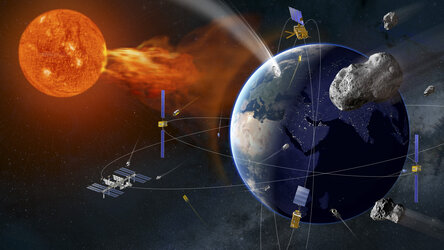Accept all cookies Accept only essential cookies See our Cookie Notice

About ESA
The European Space Agency (ESA) is Europe’s gateway to space. Its mission is to shape the development of Europe’s space capability and ensure that investment in space continues to deliver benefits to the citizens of Europe and the world.
Highlights
ESA - United space in Europe
This is ESA ESA facts Member States & Cooperating States Funding Director General Top management For Member State Delegations European vision European Space Policy ESA & EU Space Councils Responsibility & Sustainability Annual Report Calendar of meetings Corporate newsEstablishments & sites
ESA Headquarters ESA ESTEC ESA ESOC ESA ESRIN ESA EAC ESA ESAC Europe's Spaceport ESA ESEC ESA ECSAT Brussels Office Washington OfficeWorking with ESA
Business with ESA ESA Commercialisation Gateway Law at ESA Careers Cyber resilience at ESA IT at ESA Newsroom Partnerships Merchandising Licence Education Open Space Innovation Platform Integrity and Reporting Administrative Tribunal Health and SafetyMore about ESA
History ESA Historical Archives Exhibitions Publications Art & Culture ESA Merchandise Kids Diversity ESA Brand Centre ESA ChampionsLatest
Space in Member States
Find out more about space activities in our 23 Member States, and understand how ESA works together with their national agencies, institutions and organisations.
Science & Exploration
Exploring our Solar System and unlocking the secrets of the Universe
Go to topicAstronauts
Missions
Juice Euclid Webb Solar Orbiter BepiColombo Gaia ExoMars Cheops Exoplanet missions More missionsActivities
International Space Station Orion service module Gateway Concordia Caves & Pangaea BenefitsLatest
Space Safety
Protecting life and infrastructure on Earth and in orbit
Go to topicAsteroids
Asteroids and Planetary Defence Asteroid danger explained Flyeye telescope: asteroid detection Hera mission: asteroid deflection Near-Earth Object Coordination CentreSpace junk
About space debris Space debris by the numbers Space Environment Report In space refuelling, refurbishing and removingSafety from space
Clean Space ecodesign Zero Debris Technologies Space for Earth Supporting Sustainable DevelopmentLatest
Applications
Using space to benefit citizens and meet future challenges on Earth
Go to topicObserving the Earth
Observing the Earth Future EO Copernicus Meteorology Space for our climate Satellite missionsCommercialisation
ESA Commercialisation Gateway Open Space Innovation Platform Business Incubation ESA Space SolutionsLatest
Enabling & Support
Making space accessible and developing the technologies for the future
Go to topicBuilding missions
Space Engineering and Technology Test centre Laboratories Concurrent Design Facility Preparing for the future Shaping the Future Discovery and Preparation Advanced Concepts TeamSpace transportation
Space Transportation Ariane Vega Space Rider Future space transportation Boost! Europe's Spaceport Launches from Europe's Spaceport from 2012Latest

Testing a fiery reentry
Thank you for liking
You have already liked this page, you can only like it once!
What would a satellite look like as it burns up in the atmosphere? Researchers attempted to duplicate this fiery fate for a bulky satellite electronics box using a plasma wind tunnel.
Their goal was to better understand how satellites burn up during reentry, to minimise the risk of endangering anyone on the ground. Taking place as part of ESA’s Clean Space initiative, the testing occurred inside a plasma wind tunnel at the DLR German Aerospace Center’s site in Cologne.
The item seen here is a section of a satellite electronics box, measuring 300 x 200 x 150 mm across – the full-sized box being too large to fit inside the 120 mm-diameter plasma wind tunnel. This aluminium-made section of box also contained a backplane connected to four electronics cards made of glass fibre reinforced plastic.
The testing investigated the box’s fragmentation behavior, including how the electronics cards were released from the housing, to verify the predictions of reentry simulation software. Other heavy satellite parts were also subjected to this ‘ablation’ testing, including a ball bearing unit, reaction wheel, magnetotorquer, flywheel unit, battery module and battery cells.
In theory reentering space hardware is vaporised entirely in the course of plunging through the atmosphere. In practice some pieces can make it all the way down to Earth – some of them big enough to do serious damage.
Modern space debris regulations demand that such incidents should not happen. Uncontrolled reentries should have a less than 1 in 10 000 chance of injuring anyone on the ground.
As part of a larger effort called CleanSat, ESA is developing technologies and techniques to ensure future low-orbiting satellites are designed according to the concept of ‘D4D’ – Design for Demise.
See the video of the testing here.
-
CREDIT
ESA -
LICENCE
ESA Standard Licence
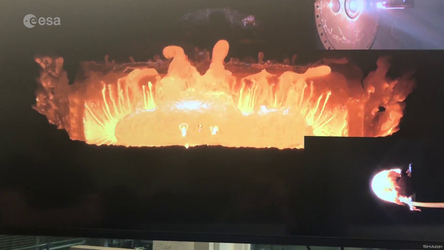
Melting a piece of a satellite
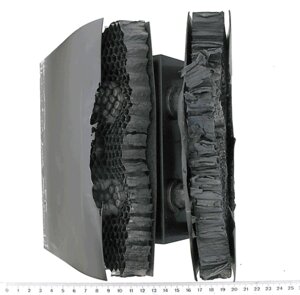
Satellite panel following reentry testing

Reentry test of QARMAN CubeSat
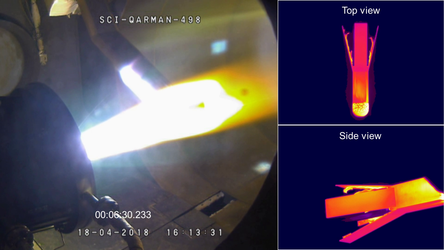
Reentry CubeSat’s plasma wind tunnel testing
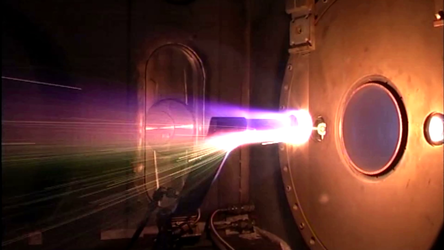














 Germany
Germany
 Austria
Austria
 Belgium
Belgium
 Denmark
Denmark
 Spain
Spain
 Estonia
Estonia
 Finland
Finland
 France
France
 Greece
Greece
 Hungary
Hungary
 Ireland
Ireland
 Italy
Italy
 Luxembourg
Luxembourg
 Norway
Norway
 The Netherlands
The Netherlands
 Poland
Poland
 Portugal
Portugal
 Czechia
Czechia
 Romania
Romania
 United Kingdom
United Kingdom
 Slovenia
Slovenia
 Sweden
Sweden
 Switzerland
Switzerland














